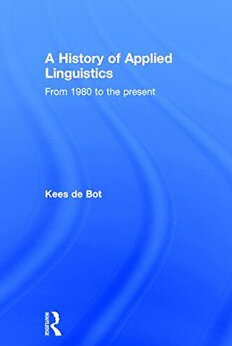
A History of Applied Linguistics: From 1980 to the present PDF
Preview A History of Applied Linguistics: From 1980 to the present
A History of Applied Linguistics How has Applied Linguistics been defined and how has the field of Applied Linguistics developed over the last 30 years? Who were the leaders that pushedthe agenda? What are the core publications in the field? Whoare the authors that have been cited most and how is that related to leadership? What were the main themes in research? Why did formal linguistic theories lose so much ground and the interest in more socially oriented approaches grow? What has been the impact ofApplied Linguistics on languageteaching? Adopting a theme-based approach, this book answers these questions and more and forms a history of Applied Linguistics from 1980. The structure of this book is largely defined by the topics covered in interviews with 40 leading international figures including Rod Ellis, Diane Larsen-Freeman, Henry Widdowson, Suresh Canagarajah and Claire Kramsch. Supplemented with questionnaires from a further 50 key applied linguists, thisisessentialreadingforanyonestudyingorresearchingAppliedLinguistics and will be of interest to those in the related area of English Language Teaching. Kees de Bot is Chair of Applied Linguistics and head of department at the UniversityofGroningen, theNetherlands.Heisthe co-author ofmanytitles including Second Language Acquisition (Routledge, 2005) and the co-editor of Language Development Over the Lifespan (Routledge, 2009). This page intentionally left blank A History of Applied Linguistics From 1980 to the present Kees de Bot AddAddAddAdd AAAdddddAdAddddAdd AddAdd AdAddd Firstpublished2015 byRoutledge 2ParkSquare,MiltonPark,Abingdon,OxonOX144RN andbyRoutledge 711ThirdAvenue,NewYork,NY10017 RoutledgeisanimprintoftheTaylor&FrancisGroup,aninformabusiness ©2015KeesdeBot TherightofKeesdeBottobeidentifiedastheauthorofthisworkhas beenassertedbyhiminaccordancewithsections77and78ofthe Copyright,DesignsandPatentsAct1988. Allrightsreserved.Nopartofthisbookmaybereprintedorreproduced orutilisedinanyformorbyanyelectronic,mechanical,orothermeans, nowknownorhereafterinvented,includingphotocopyingandrecording, orinanyinformationstorageorretrievalsystem,withoutpermissionin writingfromthepublishers. Trademarknotice:Productorcorporatenamesmaybetrademarksor registeredtrademarks,andareusedonlyforidentificationandexplanation withoutintenttoinfringe. BritishLibraryCataloguing-in-PublicationData AcataloguerecordforthisbookisavailablefromtheBritishLibrary LibraryofCongressCataloging-in-PublicationData DeBot,Kees,author. Ahistoryofappliedlinguistics:from1980tothepresent/ByKeesdeBot. pagescm Includesindex. 1.Languageandlanguages–Studyandteaching–History.2.Applied linguistics. P61.D442015 418.009–dc23 2014037939 ISBN:978-1-138-82065-4(hbk) ISBN:978-1-138-82066-1(pbk) ISBN:978-1-315-74376-9(ebk) TypesetinGoudy byTaylor&FrancisBooks This book is dedicated to Theo J.M. van Els and Richard D. Lambert who shaped my future This page intentionally left blank Contents List of figures xi List of tables xii Preface xiii 1 Introduction 1 2 The informants 8 2.1 Demarcation problems 8 2.2 Representativeness 9 2.3 Gender aspects 12 2.4 Race 13 2.5 Age 13 2.6 Multilingual applied linguists? 14 2.7 Educational background 15 2.8 Affiliation with AL 17 2.9 Influenced by … 21 2.10 Influence on … 22 2.11 Conclusion 23 3 Defining AL 25 3.1 An inclusive or exclusive definition? 26 3.2 The autonomy of AL 31 3.3 Unity, fragmentation or compartmentalization? 31 3.4 AL and TESOL 32 3.5 AL and AILA 32 3.6 Conclusion 34 4 The leaders 36 4.1 Criteria for leaders 36 4.2 The list of leaders 38 4.3 Portraits of the main leaders 40 4.4 Conclusion 48 viii Contents 5 Most important articles and books in AL 50 5.1 Most important articles 50 5.2 Most important books 53 5.3 The role of publishers 55 5.4 Conclusion 56 6 Main trends I: theoretical and methodological aspects 57 6.1 Theoretical aspects 57 6.1.1 Linguistic theories 57 6.1.2 Theory construction and Second Language Acquisition (SLA) 61 6.1.3 The relativist/rationalist debate 61 6.1.4 The growth of Socio-Cultural Theory 62 6.1.5 Foundational sources and reinventing the wheel 63 6.1.6 Definition of concepts 64 6.2 Research methodology 64 6.2.1 Research methods 64 6.2.2 The impact of corpus linguistics 65 6.2.3 Discourse analysis and conversational analysis 66 6.2.4 Critical approaches 66 6.2.5 Neurolinguistics and the neurobiology of language 67 6.2.6 The role of technology 67 6.2.7 Ethics in testing 68 6.2.8 Meta-analyses and overview studies 68 6.2.9 Other research populations 69 6.2.10 International comparisons 70 6.2.11 Generalizability 70 6.3 Conclusion 71 7 Trends II: psycholinguistic, sociolinguistic and educational aspects 73 7.1 Psycholinguistic aspects: language and cognition 73 7.1.1 The role of input, output and interaction 73 7.1.2 Transfer and cross-linguistic influence 74 7.1.3 Language attrition and language loss 75 7.1.4 Individual differences 75 7.2 Sociolinguistic aspects: language in context 77 7.2.1 Multilingualism and L3 77 7.2.2 Language shift 78 7.2.3 Language and identity 78 7.2.4 The spread of English and English as a Lingua Franca (ELF) 79 Contents ix 7.2.5 Variation and variability 80 7.2.6 Language policy 81 7.2.7 The linguistic landscape 83 7.3 Educational aspects 83 7.3.1 Vocabulary acquisition 84 7.3.2 Task-based language teaching (TBLT) 84 7.3.3 Teacher education 85 7.4 Conclusion 86 8 Trends III: the dynamic turn 87 8.1 Complex Dynamic Systems Theory (CDST) 87 8.2 CDST and multilingual processing 90 8.3 Characteristics of CDST-based models of bilingual processing 93 8.4 Code switching (CS) as language production 94 8.4.1 Sources of triggering in code switching 94 8.4.2 CS as a critical state 95 8.5 The analysis of language variation 97 8.6 Individual differences and CDST 99 8.7 CDST and timescales 101 8.8 Concluding remarks 103 9 The citation game 106 9.1 Data sources for citation analysis 106 9.2 Using Hirsch’s h-index 108 9.3 Number of citations as an indicator 110 9.4 A database of applied linguists and their citations 110 9.5 The impact of publications over time 111 9.6 Factors influencing citation scores 113 9.7 Leaders and citations 114 9.8 Cronyism, ignorism, Matthew effects and other dubious practices 115 9.9 The risk of publication pressures 116 9.10 AL journals and their impact 116 9.11 More advanced analyses 117 9.12 Conclusion 118 10 The impact of applied linguistic research on language learning and teaching 122 10.1 I don’t know 122 10.2 No application 122 10.3 Negative impact 123 10.4 Little or no impact 123
